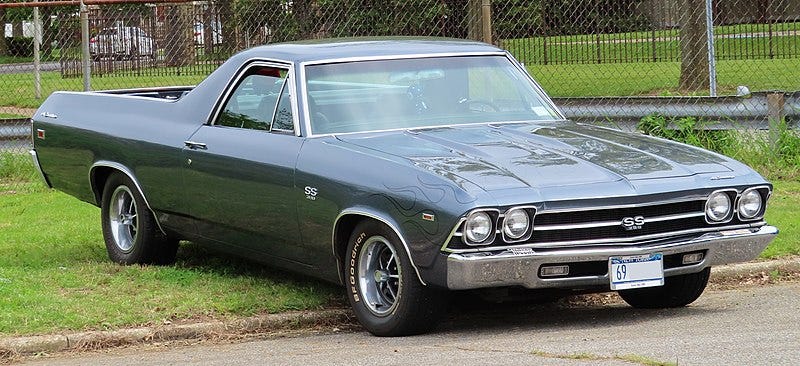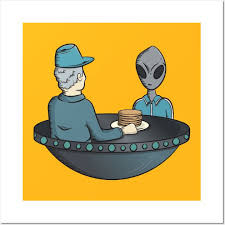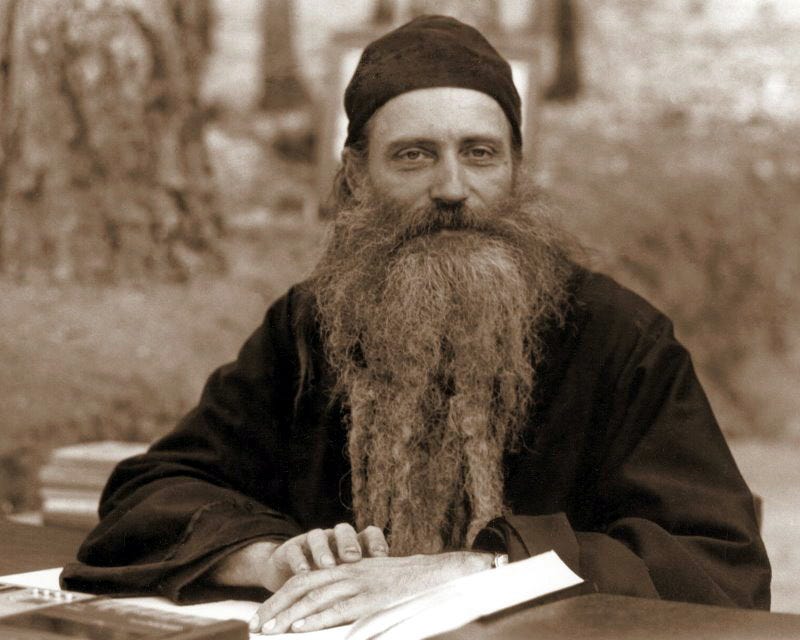I had originally planned on writing an essay on this theme for some time, as it relates to some of the ideas I explored in one of my earliest pieces, “History and Memory.” I have always found it fascinating how we set the boundaries of the possible in our understanding of the human experience, boundaries which were very different in the past.
‘s recent piece mentioning Jacques Vallée inspired me to pair the below essay with my next piece on how this same theme has played out in some of the scariest films I’ve ever seen, which will be out in time for Halloween.On April 18th, 1961, plumber and poultry farmer Joe Simonton of Eagle River, Wisconsin was eating lunch in his kitchen when he noticed a large object descending onto his driveway. Fearing that his roof had somehow slid off, he went outside, only to discover that it was in fact a nearly 40’ diameter chrome “flying saucer.” A hatch opened on the craft, and a being described by Simonton as a '“man” around five feet tall, wearing a black outfit (complete with cap and turtleneck) resembling an “Italian” emerged, holding a jug that appeared to be made of the same Chrome material as the craft. Reports differ as to whether the “man” got out of the craft or merely stood in the hatchway. The “man” somehow indicated, without speaking, that he needed water, and Simonton obligingly took the jug and filled it. When he returned, he noticed that there were actually three “men” inside the craft. Leaning against it he looked in to see that there were control panels, lights, and switches, though the interior was black like wrought iron. One of the “men” was standing at a griddle, cooking pancakes. Having brought the water, Simonton seems to have been a bit put off by the fact that the “men” weren’t speaking to him, so in the interest of furthering conversation, he indicated the griddle and the pancakes. The “man” frying them up handed three to him; Simonton ate one, which he claimed tasted like “cardboard.” Then, without ever speaking, the “man” with the jug closed the hatch so tightly that the seam couldn’t be seen and the craft lifted off, tilted 45 degrees, and flew away. Simonton noticed that there were exhaust pipes, six or eight inches in diameter.
So, to recap, a UFO landed in the front yard of a Wisconsin chicken farmer. The inhabitants asked for a jug of water, gave the farmer some pancakes in return, and flew away. The obvious question is, what really happened? Or is it?
There is a lot of power in that phrase: what really happened? It’s like a magic spell that abjures phantasms. You say the words, and then -poof- what seems to have happened is gone and what remains is, well, what really happened. But it takes more work to get to real than I think we realize. Real and real aren’t necessarily the same thing. The first is the sum of the assumptions we bring a priori to a chain of inductive reasoning; the latter is metaphysical, what is understood to be true after a process of deductive reasoning. This is something I’ve dealt with a lot in historiography, something everyone who studies human society, culture, art, religion, etc. must come to grips with. The sort of experience Joe Simonton had that spring morning in his driveway is a human universal, an encounter with something so outside the realm of normal experience as to make one question one’s grasp of the possible. Not everyone will have such an experience, but every culture is shaped, profoundly, by those who do. It is in the interpretation of those experiences that some consensus of real is established.
Let us establish the parameters of this experience. Simonton saw the UFO in the middle of a clear day while being fully awake and of established sound mind. The encounter lasted for around five minutes. He spoke directly to at least one of the occupants of the craft, made extended physical contact with the craft and objects from it, and retained physical evidence of the encounter in the form of the pancakes. Simonton gave one of the pancakes to a local judge, who contacted NICAP (National Investigations Committee on Aerial Phenomena) and gave it to them. They in turn had it scientifically analyzed, as did the Air Force on another pancake. The existence of the pancakes, if not their provenance, is as well-established as anything can be. There is thus no room for ambiguity or mistake on his part. If he had told the exact same story, but with Mexicans in an El Dorado instead of Italians in a flying saucer, and had the tortillas to prove it, it is doubtful anyone would find the account, well, doubtful.
Due to DEI mandates, there are apparently no stock photos of Mexicans in El Caminos.
Reading this, the modern man or woman of sober temperament has probably now digested the above evidence and produced a reflexive interpretation: Simonton is lying. This is the most likely thing; what really happened is that nothing happened. I presented the evidence for the encounter and none for his character in any sense, and yet for most people the former is ignored and the latter is assumed. NICAP, the UFO group mentioned above, while remaining agnostic as to the case as a whole, came to deception as a probable conclusion. Their reasoning, however, was interesting. NICAP claimed that Simonton had a financial motive to lie, as he had begun, by the time of their investigation, selling copies of the articles about him and interviews for a dollar each. For his part, Simonton claimed that his work as a plumber had dried up in the wake of his notoriety and that his hens had begun dying off, which he connected to the UFO encounter. It is thus a bit of a chicken or egg scenario (yes I went there) as to whether the need for money arose from the visitation, or preceded it in the form of a hoax. He certainly never got rich and quickly came to hate publicity. Interestingly, the NICAP subcommittee that reported on the case seems to have placed great significance in Simonton’s career as a plumber, pointing out as discrepancies the fact that he had to go to his basement to get water for the “men” (why would a plumber not have indoor plumbing?) and the fact that he could not gauge whether the exhaust pipes on the craft were six or eight inches in diameter (“a plumber would know,” one actually wrote).
This seems to me a bit of a stretch, that a man encountering a UFO would be able to accurately eye-measure the diameter of its exhaust pipes as it flew away. I would call it more like rationalization. The need to explain this encounter in terms of what is real meant squeezing the facts into such boundaries as would hold them and pruning away the inconvenient or bizarre elements. The need for it to be real meant that it couldn’t be real. But whence that need?
In my history classes, at the beginning of the year, I introduce the idea that the people of the past, and many in the present, have a different idea of what is real than is common today. I offer the following as an example. If I were to tell you that Abraham Lincoln learned to ride a horse when he was 12, very few people would doubt that or ask for any evidence for my claim. He lived on the frontier, horses were common, and such would be expected. If I said, however, that Lincoln learned to ride an elephant when he was 12, most would want more proof for that claim. Certainly, however, we agree that elephants were a thing, that there were travelling circuses, and perhaps young Abe got to ride one at some point. A daguerreotype of Lincoln with a silver-tinted pachyderm would silence all the haters. Suppose, though, that I said that Lincoln learned to ride a rhinoceros at 12. Now this is wildly implausible. A rhino is a savagely aggressive animal which is generally held to be wholly untamable. However, it is an actual creature with an actual back, so it theoretically could be ridden. But one would want not only physical photos but also multiple contemporary eyewitness accounts, and perhaps even the stuffed and mounted carcass of Old Horny to analyze, complete with a DNA-sequenced beard hair from Lincoln’s first adolescent attempt at his signature look embedded in the beast’s hide from a tearful farewell hug the future president gave him shortly before shooting him for having rabies, Old Yeller style.
“No, Ma, I’ll do it. He’s my rhino.”
Now imagine, however, that I told you that at the age of 12 Abraham Lincoln learned to ride a unicorn. Imagine I had all the evidence I noted above. Now imagine how believable it would be nonetheless. The photo was shopped. Physical media? It was smuggled in by pranksters. The stuffed and mounted unicorn- same thing- some sick taxidermist put together an unholy blend of donkey and narwhal. Lincoln’s own hair- grave robbers. After all, if someone can get a hair indisputably Lincoln’s to serve as the control, certainly someone could have filched one as the independent variable. In short, the exact same physical evidence that served to prove the former scenarios true would be useless in the latter case. It would all be explained away in a way that would seem an absurd stretch in the other cases. Why?
Here is where the metaphysics come into play. Before science and empirical evidence can have any meaning parameters must be established as to what sort of universe we live in and what is possible within it. This is not itself, and cannot be, an empirical question. The senses cannot tell us whether what the senses perceive is real. The senses, after all, can be deceived, and the notion that they can be deceived is predicated upon the idea that there is a higher sort of reality against which the evidence of the senses can be measured. It is possible that Lincoln could ride a horse, an elephant, or a rhino because we live in the sort of universe where those things are themselves possible, and it is impossible that Lincoln could ride a unicorn, because we do not live in a universe where magical creatures are a thing. All physical evidence perceptible to the senses must fit into that understanding to be considered real.
This is one reason why cases like Simonton’s arouse in the modern mind feelings of both wonder and unease. They challenge our notions of our grasp on the world as it really is. Jacques Vallée, in his Passport to Magonia, references Simonton and contextualizes his experience in terms of similar encounters throughout human history. He notes that stories about fairy beings giving food to humans are common in at least the Western tradition, and that even the details about the pancakes containing buckwheat and lacking salt have parallels with encounters from pre-modern times. There is no evidence that Simonton was aware of these particular traditions, but interestingly, his innate Midwestern niceness compelled him to behave in a way that would have been SOP for anyone in the Middle Ages who encountered such beings. The “men” appeared, asked for hospitality, he obliged, they gave a gift of food, and departed.
The framing of the encounter as one of “aliens from another planet” is a modern construct, and nothing in the encounter itself lends itself explicitly to that interpretation. Indeed, one of the reasons that NICAP was skeptical was that the incident plainly made no sense in terms of how they imagined aliens would appear and behave. There was no reason to stop at Simonton’s house for water in a rural area where water was available anywhere. Why did a spaceship with no visible means of propulsion have exhaust pipes like a Chevy? Why were they Italians? One should note here that illustrations from later periods depict the “men” as typical Grey aliens, which is not what Simonton described.
This is true of all “alien” encounters to one degree or another. Paradoxically, the more believable they are as actual encounters (as opposed to blatant hoaxes) the more they come festooned with bizarre and irrational elements that make no human sense. The ‘technology’ on display is always one degree beyond that of the observer, the beings just foreign enough to feel alien (Betty and Barney Hill described their abductors as “Irishmen”). Fr. Seraphim Rose, one of the most profound modern Orthodox theologians and cultural critics, notes in his analysis of the phenomenon in Orthodoxy and the Religion of the Future, by way of Vallée, that:
“Only lately [ca. 1975] have serious investigators begun to agree that UFOs, while having certain “physical” characteristics, cannot at all be explained as somebody’s “space ships,” but are clearly something of the paraphysical or occult realm.” -131 [129]
Everything he wrote is absolute gold.
While describing them as Italians, Simonton was clear that he felt that the beings he encountered were somehow inhuman. He noted that he could not look them in the eye, as their gaze made him uncomfortable. He later told a neighbor that he felt they were reading his mind. As noted, the encounter left him worse off as a whole. He never came to any conclusion as to what it all meant. Rose speculates that the absurdity is the point, that the very strangeness of the encounters are what draw attention to them, their irrationality the seed of wonder that compels both those who experience them and those who learn about them secondhand to speculate, endlessly and fruitlessly, on their meaning. They want us to think about them, but since there is nothing to know, or that can be known, we are driven a bit mad in the attempt.
Fr. Seraphim states plainly that the phenomenon is demonic, a position I find credible as best fitting the evidence. The two most salient characteristics of demons is that they are cruel and absurd. Their miracles are the opposite of those of God, flashy and compelling without meaning. For my part, I hold that the universe we live in is a fallen place, alienated from God by primordial sin, and that our doors of spiritual perception, for our benefit, are largely closed to shield us from the full implications of that separation from God. In other words, if we knew what kind of spiritual horrors surrounded us, we would go still more insane than we have. Sometimes, however, the doors open, either with God’s blessing (a holy man with the gift of clairvoyance) or in a way contrary to God (a sorcerer or the like). Based on that fundamental understanding, here is what I believe happened that day.
For some reason known only to beings more subtle than myself, Joe Simonton found his doors of perception opened to a deeper reality than the senses normally allow. In that state, he encountered beings that wanted to be encountered, that wanted to not only be experienced, but remembered and discussed, to spread a mind-virus of wonder and menace; this is all that can possibly be inferred, given the understanding of the universe I described. Simonton responded with good-natured friendship and kindness to these creatures, which is my best guess as to why their effect on him was not more malignant than it was. They came, did absurd but memorable things, and departed, leaving Simonton, his neighbors and those who’ve read about it since with an impossible quest to make sense of it all. Simonton suffered a bit, but seems to have been a basically decent man who eventually got tired of the whole business and put it behind him. One detail you might have noticed from the video was the tire swing hanging from the tree behind him. I suspect he had grandchildren, and a family that grounded him and prevented him from going off the deep end. This is, unfortunately, not the case with everyone who encounters such beings. In the follow-up to this, I will explore how this theme of the encounter with the unearthly has been explored artistically in film, and I believe that the way both the real and fictional encounters have been interpreted have much to say about the human condition.










Maybe they just really wanted pancakes ;)
The high strangeness of this kind of encounter is certainly an argument against the entities being aliens. However, it isn't airtight. These encounters frequently involve psychic effects, as indeed the Simonton case does. Entities that have mastered telepathy could, I suspect, quite easily project false images as a form of camouflage. They could be invisible, but they could also make themselves visible in deceptive ways, allowing just enough of a true image through to enable interaction (on their terms), while being false enough to maintain operational secrecy. Not only is the contactee kept in a state of confusion, but the resulting absurdity of the encounter is an obstacle to the belief of others.
Recently I was chatting with a skeptic, a man with a background in astronomy who has put no little thought into this matter. He said that about the only thing that would convince him would be a direct, face to face encounter. I found this interesting, because such encounters are the most convincing on an individual basis but the least convincing on a societal scale.
This post is wonderfully thought-provoking! Your analysis of Simonton's encounter "feels" correct (demonic in nature), at least compared to the explanations possible under alternate metaphysical framings.